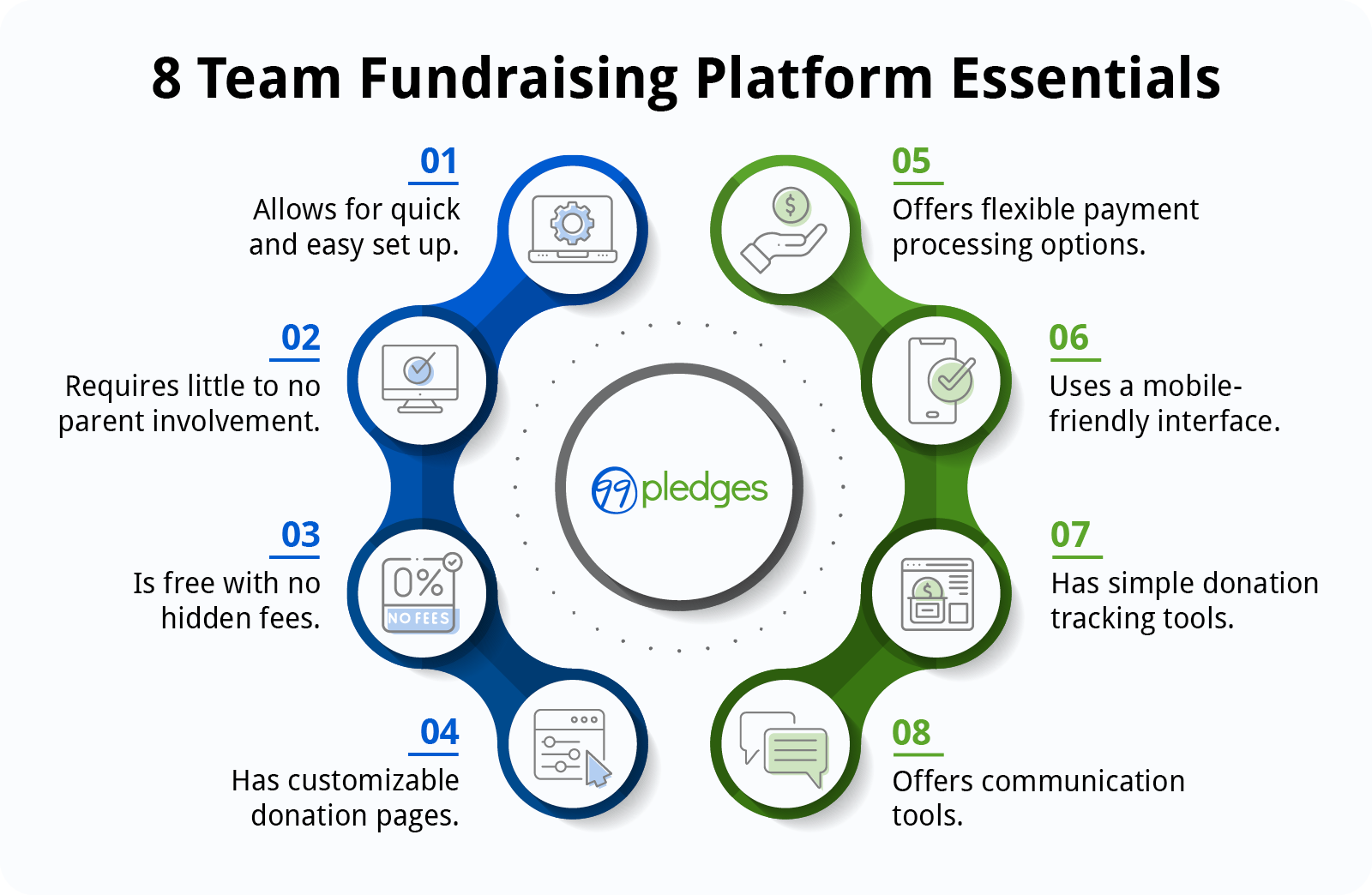5 Unique Strategies to Level Up Your Team’s Fundraisers
School and community sports teams alike often struggle to garner the funds they need to cover program costs. Even if your team seeks out grants or asks parents to pay fees, you may find yourself turning to fundraising to cover various costs.
While fundraising campaigns do have benefits, like helping you build a strong community of supporters, they can also put a strain on your already thin resources. However, fundraising doesn’t have to distract from your work on the field or in the gym. In this guide, we’ll explore strategies designed especially for team fundraising that will boost your revenue and attract new donors. Let’s get started!
1. Use team fundraising software.
Not all fundraising technology is created equally—and that’s okay.
Different solutions cater to different organizations and fundraising styles. Software for enterprise-level nonprofit fundraising, for example, is designed for complex fundraising needs your team will likely never have. Even if your team already uses a fundraising tool, it’s worth reevaluating its features and the cost of using it.
As 99Pledges’ guide to team fundraising platforms explains, the following eight features and attributes are essential in your software:

- Quick and easy setup. Ideally, the provider should set up your campaigns for you. Make sure they offer both teamwide and individual donation pages to accommodate your needs.
- Little to no need for parental involvement. Your athlete’s parents are just as busy as you, if not more—plus, relying on parents to get the ball rolling can give your campaign a slow start. Operate with urgency by choosing software that eliminates or pares down parents’ responsibilities.
- Free, without hidden fees. In the software world, “free” can feel like a myth or empty promise. Avoid systems that are advertised as free but have paid (yet necessary) add-ons or minimums. While it’s normal for your organization to need to cover credit card transaction fees, some services may take a certain percentage of your earnings as a “payment” for using the tool—watch out for this.
- Customizable donation pages. Encourage supporters to take action when they reach your donation with compelling customization. Add a description telling your story, your team’s branding, and photos of the athletes to inspire more support.
- Flexible payment options. Make donating easy and convenient for donors by accepting a variety of payment methods. Process cash and check payments, debit and credit cards, PayPal, ApplePay, and GooglePay.
- Mobile-friendly interface. Engaging with your campaigns should be just as easy as donating. The software’s donation pages should be accessible from any device.
- Simple donation tracking tools. To measure success, you need to have the hard numbers. Select a tool that will track each donation to reveal progress toward your revenue goal.
- Communication tools. Communicating with your audience allows your team to attract, engage, and retain more loyal supporters. Invest in software that can automatically share donation receipts, thank-you emails, and reminders.
Practice due diligence to uncover any conditions or fees that could be tucked away in a solution’s fine print. Consider setting up demo meetings with your top candidates to see the software in action, and come prepared with a list of clarifying questions.
2. Leverage your built-in support system.
Your sports team already has a dedicated group of fans who cheer you on during games and competitions: your athletes’ parents, families, and friends! By regularly registering for your events and purchasing tickets, they’ve already shown that they are willing to support your team financially.
To maximize the support you receive from event attendees, try out ideas like:
- Selling branded merchandise. Sell merchandise at games or other events that your team’s supporters will attend. To appeal to your audience’s fear of missing out, create merchandise that is exclusive to a single year, season, or even game (think a homecoming or rivalry game). Offer the merchandise on your website so supporters can buy it at any time.
- Hosting fundraisers during sporting events. Weave a smaller fundraiser into a major, high-attendance event. If you direct a marching band, for example, you could sell shout-outs that are read by the announcer at competitions. Then, parents can share a public message with their child during the event while funding your group.
- Offering concessions. Whether you’re hosting a football game under the Friday night lights or a mid-week evening soccer game, attendees are likely to get hungry. Conveniently serve up classic sporting event snacks like hot dogs, burgers, pizza, fries, and chicken tenders.
To drum up more excitement at the event, sell raffle tickets and hold a drawing for highly sought-after prizes. These could be anything from gift cards to local coffee shops and restaurants to team-specific prizes like VIP parking passes.
3. Rely on online fundraising.
Online fundraising tends to be safer, more cost-effective, and less time-consuming than traditional campaigns like door-to-door sales. It also takes less effort and money to kick off an online campaign, meaning you can start fundraising on a tighter timeline.
One of the top online fundraising methods is the pledge model. Team members will fundraise online on your team’s behalf, rallying support from friends and family members.
Here’s an example of how the pledge model would work for a fun run held by a tennis team:
- Your software provider helps set up a teamwide donation page and individual pages for players.
- Players collect pledged donations, which supporters make to their individual donation pages. Each donor pledges to donate $10 per mile the player runs.
- Players compete in the fun run, each wearing fitness devices that track their distance. At the end of the run, you record each participant’s total distance.
- Sally, one of the participants, runs five miles. Sally receives $50 for each donor, and because she collected 10 pledges, she raised $500 for the team!
- Once the miles run are reported for each participant, final donations are collected from supporters. Then, your team receives the funds!
Fundraising doesn’t have to take endless hours of your time and drain your resources. But to reap the benefits of streamlined, low-cost campaigns, you’ll need to hop on the online fundraising trend.
4. Lean into a theme.
Your supporters are already fans of the sport, and there are so many creative sports fundraising ideas to choose from.
Some sports-themed ideas for your team to try include:
- A hit-a-thon, kick-a-thon, or hoop-a-thon
- Field day or sports tournament
- Auction with sports-themed prizes
- Exercise classes or sports lessons
Themed fundraisers can also make your campaigns feel effortlessly cohesive and true to your team’s brand. This way, supporters will know without a doubt that the campaign is coming from your organization.
5. Promote ways to increase impact.
Spread awareness of ways that supporters can make their contributions go further through corporate giving programs like matching gifts. With matching gifts, businesses match their employees’ donations to charitable organizations. So, if a donor works for a company with a matching gift program, they can double their donation without reaching into their own wallet.
While every business has different matching gift guidelines, many choose to match contributions to nonprofits, educational institutions, and community organizations—meaning your team could be eligible!
Despite the powerful impact of matching gifts, 360MatchPro’s guide highlights that an estimated $4 to $7 billion in matching gift revenue goes unclaimed each year. Often, donors don’t know their employers offer these programs or have never heard of matching gifts! This is why it’s so important to spread awareness of these programs, provide instructions for submitting requests, and use technology that can help you identify matching gift opportunities.
Online spaces are more crowded than ever, making it difficult for fundraisers to get their campaigns noticed. However, embracing the quirks of team fundraising and relying on the passion your community has for your sport or activity can make yours stand out. These strategies, paired with comprehensive fundraising software, are sure to attract and inspire the support your campaigns need.



